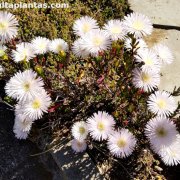Care of the succulent plant Lampranthus blandus or Pink vygie |
|
The genus Lampranthus, family Aizoaceae, comprises 250 species of succulent plants native to southern Africa. Some species are: Lampranthus blandus, Lampranthus zeyheri, Lampranthus aureus, Lampranthus amoenus, Lampranthus multiradiatus, Lampranthus spectabilis, Lampranthus falcatus. Common names: Pink vygie, Ice Plant. This species is native to South Africa. They are succulent plants with a creeping bearing that reach 25 cm (9.84") in height. They have fleshy green leaves with reddish tones. The abundant flowers are light pink in color, last a week, and only open in full sun. They bloom in spring. Pink vygie is used in rockery, on dry and sunny slopes, as covering areas of the garden that are difficult to access and in pots and planters. It combines very well with other Lampranthus species. Lampranthus blandus needs full sun exposure; the flowers do not open when the sky is cloudy. It resists occasional frost. Ice Plant can grow in poor, sandy or dry soils that have excellent drainage. The transplant is done in spring before flowering. Pink vygie is very resistant to drought. Water moderately all year long, waiting for the substrate to dry. Lampranthus blandus does not need fertilizers. Prune lightly after flowering to remove faded flowers. Pink vygie is a plant resistant to pests and diseases but sensitive to excess humidity. Lampranthus blandus propagates from cuttings in early fall. Renew the plants every 4 years as they lose their attractiveness. |
Images of the succulent plant Lampranthus blandus or Pink vygie |
Find plants
Lampranthus blandus or Pink vygie | Care and Growing
© 2026 FavThemes




